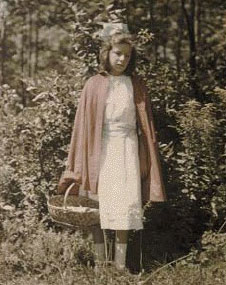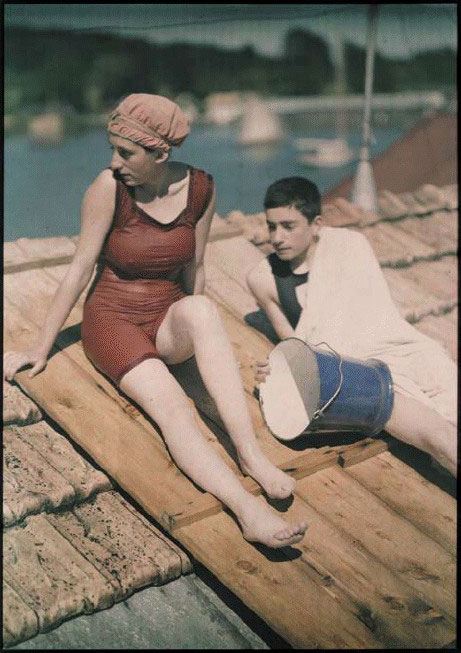- Relief printing
- Intaglio and planographic printing
- Color printing
- Bits and pieces
- Early photography in silver
- Non-silver processes
- Modern photography
- Color notes
- Color photography
- Photography in ink: relief and intaglio printing
- Photography in ink: planographic printing
- Digital processes
- Where do we go from here?
The Lumière Autochrome

A faded Autochrome, by an unknown photographer, depicting Little Red Riding Hood dressed up for her adventure with the wolf. c. 1910. 5 x 3 1/2" (12.7 x 8.9 cm)
The first practical color process was the Lumière Autochrome, invented and marketed by the same Lumière brothers, Auguste and Louis, who made the first movies. These color pictures were on glass plates and were viewed as transparencies. They consisted of a color screen superimposed upon a black and white positive, which modulated the light going through the color screen. The wild thing about the Autochrome is that it used additive color; when the more modern color processes were developed—even those used to make transparencies—they used subtractive color exclusively. The structure of the Autochrome is so crazy that I can’t resist describing it. A glass plate was coated with tiny transparent grains of potato starch that had been dyed in the additive primaries—red, green, and blue. These colors were mixed in even proportions over the plate, which therefore appeared gray when viewed through transmitted white light.

Lumière Autochrome. Photographer unknown. Bathers at Lake George. c. 1918. 6 3/4 x 4 3/4" (17.2 x 12 cm). The Museum of Modern Art, New York. Gift of Richard Benson.
The areas between the grains were dyed black. On top of this was coated a black and white photographic emulsion, which the photographer exposed in the camera with the color-screen side facing the lens. Instead of being processed as a normal black and white negative the plate was subjected to reversal processing: the negative was developed, the developed silver was bleached out before the image was fixed, and finally the remaining silver salts were developed, producing a positive image. Once the plate had been processed and dried, it could be viewed as a transparency and appeared as a full-color photograph. The Autochrome worked because the positive image—even though monochromatic—acted to modulate the amount of light that went through each grain of dyed starch. In a red area of the picture, for example, a lot of light would have passed through the red grains onto the coating of black and white emulsion when the picture was taken.
The positive was correspondingly light in that area, so a lot of light went through the red grains when the sandwich was viewed. The green grains in that same area would have blocked the red light when the exposure was made; little light went to the plate there, the positive was correspondingly dark, so the green grains, when viewed later, were “turned off” by the heavy deposit of silver behind them. In controlling the intensity of the three additive primaries, the Autochrome worked exactly the same way as the modern television or computer screen. The brightness range of the Autochrome was limited for two reasons: the black matrix in which the grains were dispersed reduced the overall transmission of light, and saturated colors were created by diminishing the brightness of unwanted colors. To make a strong blue, the red and green grains were darkened, so saturated areas were less bright, giving the Autochrome a tonal scale unlike any other process.

